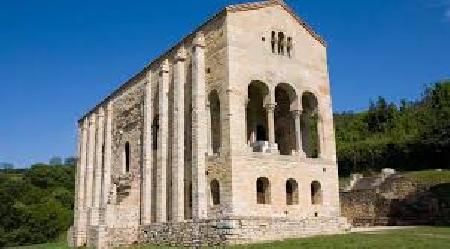Oviedo
 Oviedo is a picturesque medieval city located on a hill in the middle of the wide plains of northern Spain. Oviedo, Spain, whose name means "Old City" in Latin, is considered a true open-air museum. The main topic of tourist interest here is the well-preserved Romanesque architecture, including the fourteen churches. The old town of Oviedo - Casco Antigua - contains many attractions included in the UNESCO List, the first place of which belongs by right to the majestic Cathedral of San Salvador. Oviedo is also famous for its festivals, colorful processions with the glory of a saint or simply life itself. The city of Oviedo is famous for its unique and quite diverse architecture, represented by wide streets, old mansions, marble bridges and medieval temples, which are attended by pilgrims from all over the world. Here you can see various directions that are perfectly intertwined with each other and blend well with the surrounding space.
Oviedo is a picturesque medieval city located on a hill in the middle of the wide plains of northern Spain. Oviedo, Spain, whose name means "Old City" in Latin, is considered a true open-air museum. The main topic of tourist interest here is the well-preserved Romanesque architecture, including the fourteen churches. The old town of Oviedo - Casco Antigua - contains many attractions included in the UNESCO List, the first place of which belongs by right to the majestic Cathedral of San Salvador. Oviedo is also famous for its festivals, colorful processions with the glory of a saint or simply life itself. The city of Oviedo is famous for its unique and quite diverse architecture, represented by wide streets, old mansions, marble bridges and medieval temples, which are attended by pilgrims from all over the world. Here you can see various directions that are perfectly intertwined with each other and blend well with the surrounding space.
The largest number of historical attractions is located in the central part of the city. Many of them are listed not only on the National Register of Cultural and Historical Sites, but also on the Unesco World Heritage List. It is unlikely that you can see them all at once, so it is suggested to walk only the main ones.
Cathedral of San Salvador:
The Gothic cathedral, built in the late 13th century on the ruins of a Romanesque temple, is one of the most unusual religious monuments in Spain. First of all, you only have one tower because you just didn't have enough money in the local treasury. And secondly, several artifacts of great religious value are collected within the walls of this monastery at the same time.
One of them is considered as the Sacred Chambers, where the funerary canvas taken from the head of Jesus is kept, and two unique crosses, Angeles and Victoria, which are symbols of the city and the Principality of Asturias. Equally important is the temple's pantheon with a sarcophagus and funeral urns in which representatives of the local nobility are buried. The main pride of the Cathedral of San Salvador de Oviedo is the golden altar made in the mid-14th century and the Chapel of the Holy Chamber, whose walls are decorated with unique works of ancient Asturian art.
Monte Naranco:
Monte Naranco is a small hill located in the surroundings of the city. This truly unique place has become known for a number of ancient churches that have taken refuge on its slopes. Some of them are said to have been built in the 8th and 9th centuries. There is also a famous statue of Christ, and a spacious observation deck, famous for its amazingly beautiful panorama.
Church of Santa María del Naranco:

Santa María del Naranco, considered the most important sight of Oviedo in Spain, is located at the base of the mountain of the same name, 4 km from the city. As the largest surviving Asturian temple, it is the best example of Dormanian architecture.
The Campo de San Francisco:
The Campo de San Francisco is the best place for picnics or family outings. Oviedo's "Green Lungs", as the locals call it, occupy a vast area with everything you need for a comfortable vacation: sports fields and children's games, a large artificial pond with ducks and swans, beautiful fountains and a musical box.
The main attraction of Campo de San Francisco are the numerous peacocks that walk through the park and the botanical garden, where more than 130 species of all kinds of vegetation grow. There is also a charming bronze Mafalda and an unusual flower bed that informs visitors of the current date. It is worth mentioning that both places are the park's most photographed urban objects.
Sculptures:
Among the points of interest in Oviedo is the large number of bronze statues located in the most unexpected places.
Uria Street:
Uria Street, which connects the city center with the North Station, can be called without exaggeration the main commercial artery of Oviedo. In fact, this is where you can find boutiques of international brands as famous as Mango, Stradivarius, Women s Secret, Zara or Pull & Bear.
Among other things, Calle Uria has many interesting buildings made in the neo-baroque and art deco style. In addition to a Woody Allen sculpture.
The Plaza del Fontán:
Plaza del Fontán is "the soul and stomach of Oviedo", as the famous Asturian writer José Ignacio Gracia Noriega called it. A few centuries ago there was a lake fed by natural springs, on whose shores the noble families of medieval Oviedo loved to rest. With the increasing construction of houses, it was decided to drain the lake and turn it into a plaza. The arcades appeared and served as a place for the Corral de Comédias (as public public theaters in the 16-17 centuries). In the 17th century the Teatro del Fontana was built, of which only the facade has been preserved, the predecessor of the Teatro del Fontana.




